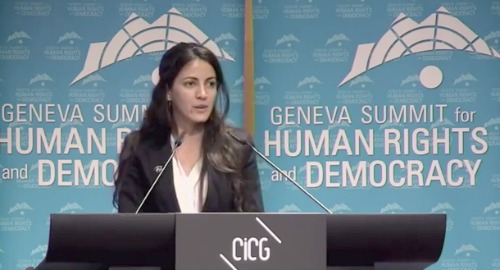Light and Liberty
by Orlando Luis Pardo Lazo and translated by Alex Higson / April 15, 2013 / No comments
The images of Oswaldo Payá and Harold Cepero covered the façade of Cuba’s diplomatic mission at New York City.

Rosa Maria Paya calls for an international inquiry into the death of father Oswaldo Paya at the Geneva Summit For Human Rights and Democracy. Photo: Human Rights UN via Youtube.
Rosa María Payá is visiting the United States from April 3 to 16. She lives in Havana and is the daughter of Oswaldo Payá Sardiñas, the Cuban dissident who won the Andrei Sakharov Prize in 2002 and founded the Christian Liberation Movement. He died alongside young Harold Cepero on July 22, 2012, in what the Cuban government classified as a “traffic accident,” convicting Spanish politician Ángel Carromero –who was driving at the time of the tragedy– of “involuntary manslaughter.” Carromero has now been deported to his own country, where he recently told The Washington Post that what happened may have been a State-sponsored assassination.

- Is it worth-while to focus on the last images and letters coming from the inside of the last living utopia on Earth? Is Cuba by now a contemporary country or just another old-fashioned delusion in the middle of Nowhere-America? A Cold-War Northtalgia maybe? Can we expect a young Rewwwolution.cu within that Ancien Régime still known as The Revolution? I would like to provoke more questions than answers.

- Orlando Luis Pardo Lazo was born in Havana City and still resides and resists there, working as a free-lance writer, photographer and blogger. He is the author of Boring Home (2009) and is the editor of the independent opinion and literary e-zine Voces.
Rosa María is hoping to win the support of the US media and authorities for an international campaign demanding an independent investigation of both deaths. She will visit New York, Washington and Miami. To honor the memory of her father and Cepero, on Saturday, April 6, exiled Cuban artist Geandy Pavón projected the image of both martyrs onto the sinister façade of Cuba’s diplomatic mission to the UN, at the corner of Lexington and East 38th Street, in front of the only military sentry box that I’ve seen in New York, and in the presence of Rosa María herself and twenty or so other companions in exile.
Geandy Pavón’s project is called Nemesis and has already paid homage to Cuban social activists who have died in suspicious circumstances, such as prisoner and hunger-striker Orlando Zapata Tamayo (in 2010) and the leader of the Ladies in White, Laura Pollán (in 2011).
During this peaceful political protest to honor his father, Rosa María announced that, “just as this light illuminates the walls of the consulate, I hope the light of truth illuminate the hearts of Cubans, and we can pave the way of reconciliation together, towards the peace, happiness, and democracy that we seek.”




